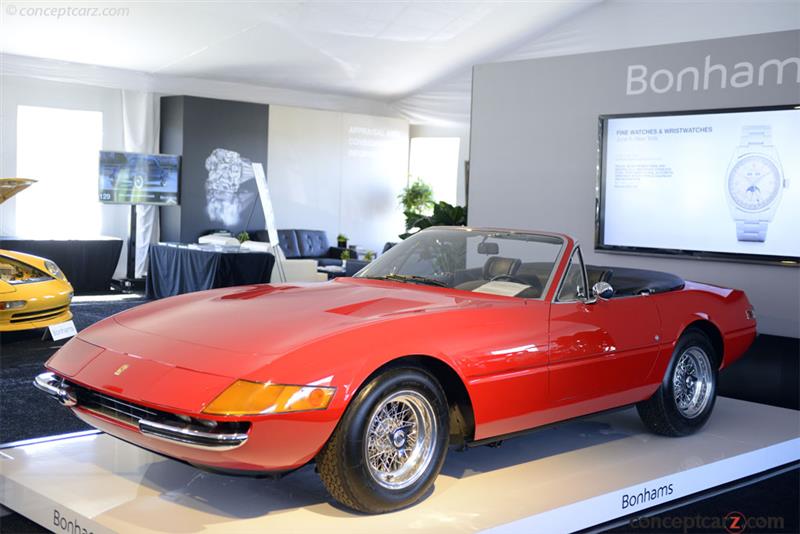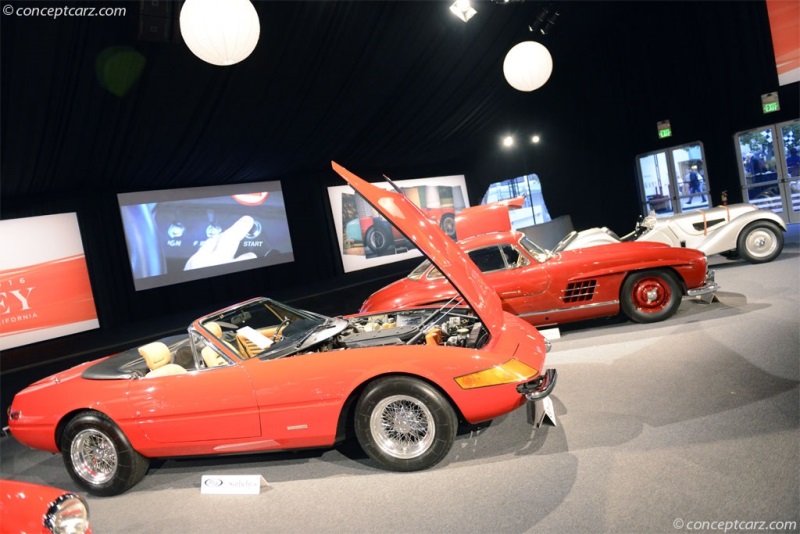Racing and competition allowed Ferrari to develop and perfect new technologies, and to foster a formidable reputation for the prancing horse of Maranello. The road-going cars, beginning with the 166 Inter, were intertwined and instrumental with the Scuderia's achievements on the track. During the mid-1960s, a rivalry between Ferrari and Ford grew to unprecedented levels, culminating with Ford's GT40's memorable victories at the 24 Hours of LeMans. Down, but not out, Ferrari retaliated in 1967 with a 1-2-3 photo finish with their P4 and P3/4 sports-racing cars at the Daytona Continental 24 Hours. 
Convertible Coupe by Scaglietti
Chassis #: 16697The V12 front-engined Ferrari 365 GTB/4 sports car was introduced at the Paris Salon in 1968 and soon gained the unofficial name 'Daytona' in honor of the sweeping 1,2,3 finish by the Ferrari sports prototype at that circuit in 1967. The influential shark-nosed styling was created by Pininfarina's Leonardo Fioravanti, later the famed carrozzeria's director of research and development. While having a muscular appearance it retained all the elegance and sophistication associated with the Italian coachbuilder's work for Maranello. The package included the traditional 'long bonnet, small cabin, short tail' appearance with a non-typical full-width transparent panel covering the headlamps, though this was replaced by electrically operated pop-up lights to meet US requirements soon after the start of production in the second half of 1969. By 1971, however, the concealed headlamps were adopted series-wide. In the front was the small, black egg-crate grille with rubber-tipped bumperettes. A matching set of bumperettes was fitted at the rear below four round taillights. Overall weight was kept to a minimum by utilizing aluminum for the doors, bonnet, and boot lid. Construction was handled by Scaglietti After Lamborghini introduced the 350 GT, Ferrari responded with adding four overhead camshafts to its road-car V12 engine of the 275 GTB (cars with this feature were given the '/4' suffix) and in the Daytona displaced 4,390cc. The 275 GTB had been introduced in 1964, wearing coachwork by Pininfarina, following the end of production for Ferrari's 250 GT SWB Berlinetta. In keeping with company tradition, its model nomenclature was derived from engine and cylinder displacement and helped differentiate the new from the old. The twelve-cylinder engine was increased from 3 liters to 3,286cc, with each cylinder displacing roughly 275 cc. In GTB/4 guise, the V12 engine had four overhead camshafts with two per cylinder bank. Known as Tipo 226, it offered as much power as Ferrari's competition twin-camshaft engine. Along with four camshafts, the Tipo 226 received several engine modifications which were bred from the company's competition efforts. These improvements propelled the new 275 GTB/4 to a top speed of 160 miles per hour. 
Convertible Coupe by Scaglietti
Chassis #: 16697The four-cam Colombo-designed V12 engine in the 365 GTB/4 with six Weber 40DCN 20 carburetors, produced 352 horsepower at 7,500 RPM and 318 lb/ft of torque available at 5,500 RPM. Utilizing dry-sump lubrication, the engine was installed low in the engine bay, while a five-speed transaxle enabled 50/50 front/rear weight distribution to be achieved. The chassis employed a long-standing Ferrari practice of being built of oval-section tubing. The chassis, 2,400mm wheelbase, much of its layout, and suspension were from the preceding 275 GTB. The suspension was an all-independent wishbone setup with coil springs. The factory claimed the 365 GTB/4 to have a top speed of 174 miles per hour and could race from zero-to-sixty mph in 5.9 seconds with the quarter-mile in 13.8 seconds. While the contemporary 365 GTC/4 was available with power steering, the Daytona was devoid of this feature. There was, however, servo assistance for the four-wheel, ventilated disc brakes, and air-conditioning was optional. 
Convertible Coupe by Scaglietti
Chassis #: 16697Luigi Chinetti's 275 GTB-based NART Spider was perhaps influential in Maranello's decision to produce a convertible version of the Daytona. First seen at the 1969 Paris Salon, deliveries commenced in 1971. Approximately 11,285 examples of the Berlinetta Coupe and just 121 Spider Convertibles were built by the time production ceased in 1973. The Spyder versions exported to the United States were stamped as '365 GTB/4' instead of '365 GTS/4.' The first 'Daytona Spyder' was displayed at the 44th Annual IIA Motor Show in Frankfurt on September 11th of 1969. Wearing yellow with a concave bodyline finish in black, the Spyder rested on Borrani wire wheels. The first Spyder had Perspex-covered headlights, while all further examples had pop-up headlights. 96 examples were sent to the United States market and 25 were built to European specifications.
by Daniel Vaughan | Apr 2020
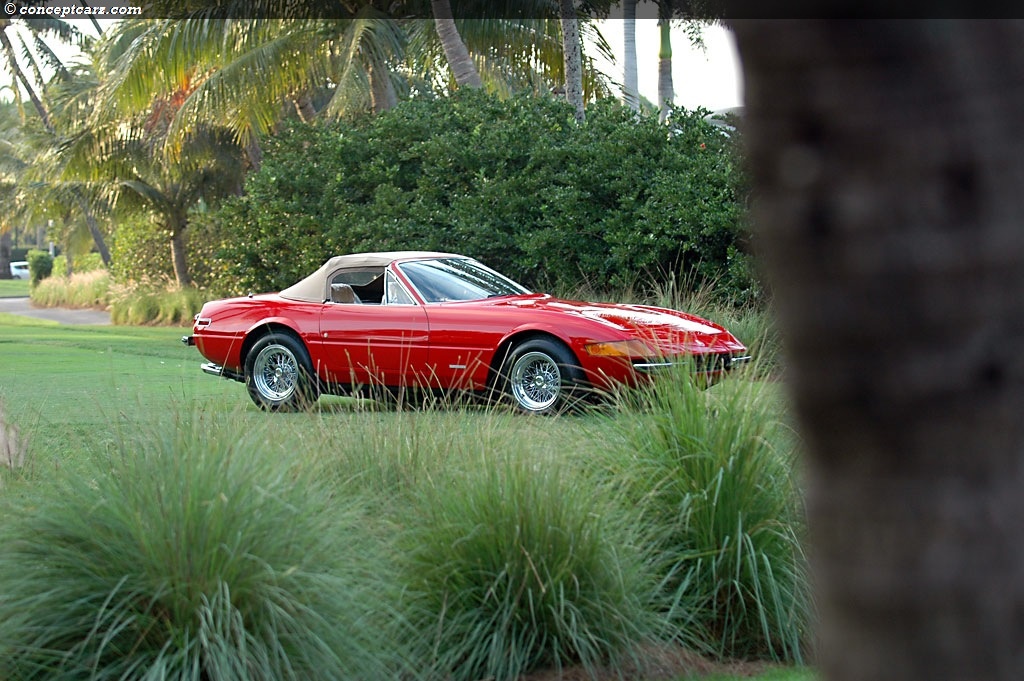
Convertible Coupe by Scaglietti
Chassis #: 16697
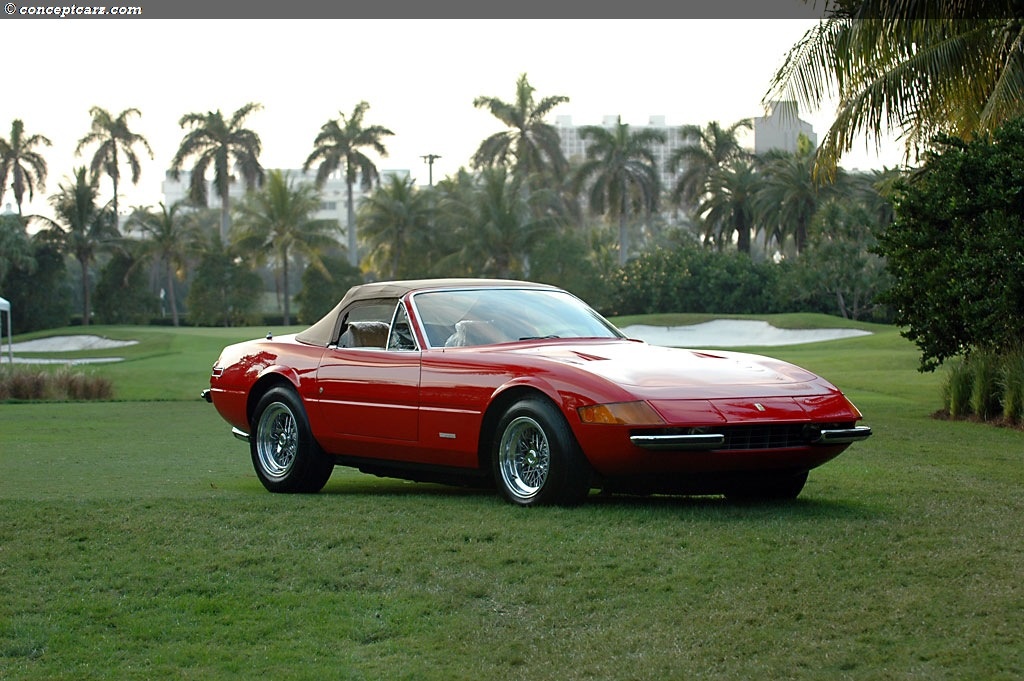
Convertible Coupe by Scaglietti
Chassis #: 16697
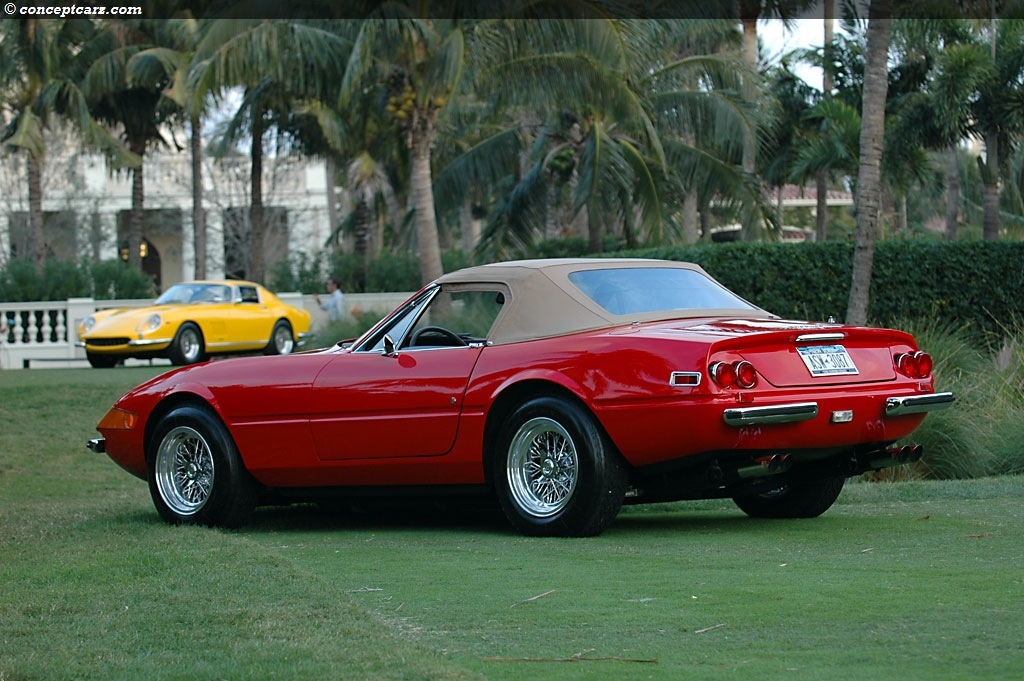
Convertible Coupe by Scaglietti
Chassis #: 16697
by Daniel Vaughan | Apr 2020
Related Reading : Ferrari 365 History
The 365 Series was introduced in the late 1960s and stayed in production until the early 1970s. The 365s were often powered by a Columbo SOHC 4390 cc V-12 engine with three Weber carburetors capable of producing around 300 horsepower. The front and rear suspension for most of the series was independent with double wishbones and coil springs. The 365 GT4 22 had an independent with transverse parallelograms....
Continue Reading >>
Continue Reading >>
Similar Automakers
1973 Ferrari 365 GTS/4 Daytona Vehicle Profiles
Convertible Coupe
Coachwork: Scaglietti
Designer: Pininfarina
Chassis #: 16857
Engine #: B2660
Gearbox #: Transaxle No. 1301
Recent Vehicle Additions
Performance and Specification Comparison
Price Comparison
$13,895 - $14,510
$23,950
365 GTS/4 Daytona Specification Comparison by Year
Year
Production
Wheelbase
Engine
Prices
Related Automotive News

Landmark Ferraris trace Maranello's race-to-road lineage at Salon Privé
Salon Privé Concours Ferraris of the 50s and 60s class is set to showcase Maranellos remarkable progress from a purely competition-focused manufacturer to one now renowned for building some of the greatest road-going sports cars in the world.
S...

Pebble Beach Auctions Online Catalogue Now Live; Historic, Unrestored 1962 Ferrari 250 GT SWB Berlinetta Unveiled as Headlining Car
Gooding %26 Company launches its entire online catalogue for the Pebble Beach Auctions, announces a remarkably original 1962 Ferrari 250 GT SWB Berlinetta along major Italian star cars.
Gooding %26 Company, the official auction house of the Pebble...

1962 Ferrari 250 GT SWB California Spider to Lead Gooding & Company's Amelia Island Auctions Alongside Stable of the Finest Ferraris
The star car of the auctions will be a one-off 1962 Ferrari 250 GT SWB California Spider, joined by a 250 GT Tour de France Berlinetta, a 250 MM Vignale Spider, and other examples of Maranellos finest models.
Leading international auction...

Celebrity Owned 1963 Ferrari 250GT Lusso Set to Take Center Stage at Russo and Steele Monterey 2015!
Scottsdale, Arizona (April 15, 2015) – By the early 1960s, Ferraris racing and street cars began to diverge in basic essence, with the Scuderias competition cars quickly becoming more specialized and the road cars reflecting the growing demand...

REVERED FERRARI 250 LM LEADS SUPERLATIVE ROSTER OF ITALIAN SPORTS CARS AT RM'S FLAGSHIP MONTEREY SALE
· RM Auctions announces a legendary 1964 Ferrari 250 LM by Scaglietti as the latest multi-million-dollar highlight for its flagship Monterey sale, August 15–16 in California
· 250 LM leads a superb roster of no less than 26 Ferraris at...































